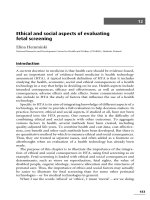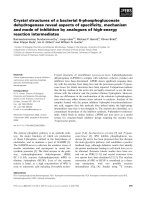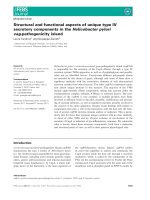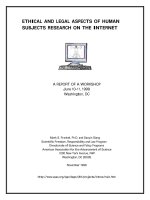Personality classic theories and modern research 6th chapter 6 behaviorist and learning aspects of personailty
Bạn đang xem bản rút gọn của tài liệu. Xem và tải ngay bản đầy đủ của tài liệu tại đây (241.5 KB, 29 trang )
Personality
Sixth edition
Chapter 6
Behaviorist and Learning
Aspects of Personality
Copyright © 2016, 2012, 2009 Pearson Education, Inc. All Rights Reserved
Modules
Introduction: Behaviorist and Learning Aspects of Personality
6.1: The Classical Conditioning of Personality
6.2: Watson's Behaviorism
6.3: The Radical Behaviorism of B. F. Skinner
6.4: Applying Behaviorism
6.5: Other Learning Approaches to Personality
6.6: Evaluation
Conclusion: Behaviorist and Learning Aspects of Personality
Copyright © 2016, 2012, 2009 Pearson Education, Inc. All Rights Reserved
Learning Objectives (1 of 2)
6.1: Interpret the classical conditioning approach of personality
6.2: Examine the genesis of behaviorism
6.3: Interpret B. F. Skinner's behaviorist approach
6.4: Apply behaviorism to explain personality differences
Copyright © 2016, 2012, 2009 Pearson Education, Inc. All Rights Reserved
Learning Objectives (2 of 2)
6.5: Probe the work done by some of the other experimental psychologists of the 1930s
and 1940s
6.6: Evaluate how theories on conditioning, reward, and extinction are relevant in current
studies of personality
Copyright © 2016, 2012, 2009 Pearson Education, Inc. All Rights Reserved
Introduction: Behaviorist and Learning Aspects of Personality
− Uniqueness of behaviorist approaches
− Behaviorism
− Partial reinforcement
Copyright © 2016, 2012, 2009 Pearson Education, Inc. All Rights Reserved
6.1: The Classical Conditioning of Personality
Objective: Interpret the classical conditioning approach of personality
Locke’s views on infants
Comparison of Locke’s approach to personality
Copyright © 2016, 2012, 2009 Pearson Education, Inc. All Rights Reserved
6.1.1: Conditioning a Response to a Stimulus
− Classical conditioning
− Pavlov’s observations
Copyright © 2016, 2012, 2009 Pearson Education, Inc. All Rights Reserved
6.1.2: Behavioral Patterns as a Result of Conditioning
− Behavioral reaction patterns
− Pavlov’s constructs
Copyright © 2016, 2012, 2009 Pearson Education, Inc. All Rights Reserved
6.1.3: Extinction Processes
− Extinction
− Outcome
Copyright © 2016, 2012, 2009 Pearson Education, Inc. All Rights Reserved
6.1.4: Conditioning of Neurotic Behavior
− Neuroticism
− Pavlov
Copyright © 2016, 2012, 2009 Pearson Education, Inc. All Rights Reserved
6.1.5: Complexities in Application of Conditioning Principles
− Complexities
− Classical conditioning
Copyright © 2016, 2012, 2009 Pearson Education, Inc. All Rights Reserved
6.2: Watson's Behaviorism
Objective: Examine the genesis of behaviorism
Behaviorist approaches philosophers
Limitations of subject analyses
Copyright © 2016, 2012, 2009 Pearson Education, Inc. All Rights Reserved
6.2.1: The Rejection of Introspection
− Behaviorism
− Psychology from the Standpoint of a Behaviorist
Copyright © 2016, 2012, 2009 Pearson Education, Inc. All Rights Reserved
6.2.2: Conditioned Fear and Systematic Desensitization
− Little Albert’s conditioned fear
− Systematic desensitization
Copyright © 2016, 2012, 2009 Pearson Education, Inc. All Rights Reserved
6.3: The Radical Behaviorism of B. F. Skinner
Objective: Interpret B. F. Skinner's behaviorist approach
B. F. Skinner
Factors responsible for behavior
Copyright © 2016, 2012, 2009 Pearson Education, Inc. All Rights Reserved
6.3.1: Operant Conditioning as an Alternative Description of Personality
− Operant conditioning
− Skinner’s rejections
Copyright © 2016, 2012, 2009 Pearson Education, Inc. All Rights Reserved
6.3.2: Controlling the Reinforcement
− Skinner box
− Process
Copyright © 2016, 2012, 2009 Pearson Education, Inc. All Rights Reserved
6.3.3: Skinner’s Behaviorist Utopia
− Walden Two
− Skinner’s proposed society
Copyright © 2016, 2012, 2009 Pearson Education, Inc. All Rights Reserved
6.4: Applying Behaviorism
Objective: Apply behaviorism to explain personality differences
Role of biological factors
Role of environment in hereditary characteristics
Copyright © 2016, 2012, 2009 Pearson Education, Inc. All Rights Reserved
6.4.1: Internal Processes, External Causation, and Free Will
− Characteristics of organisms
− Similarities between Freud and Skinner
Copyright © 2016, 2012, 2009 Pearson Education, Inc. All Rights Reserved
6.5: Other Learning Approaches to Personality
Objective: Probe the work done by some of the other experimental psychologists of the 1930s and 1940s
Experimental psychologists’ beliefs in 1930s and 1940s
Internal characteristics of organisms
Copyright © 2016, 2012, 2009 Pearson Education, Inc. All Rights Reserved
6.5.1: The Role of Internal Drives
− Clark Hull’s emphases
− Primary drives of organisms
Copyright © 2016, 2012, 2009 Pearson Education, Inc. All Rights Reserved
6.5.2: Social Learning Theory
− Neil Miller’s research
− Dollard’s and Miller’s study of personality
Copyright © 2016, 2012, 2009 Pearson Education, Inc. All Rights Reserved
6.5.3: Habit Hierarchies
− Concept of secondary drive
− Harlow’s studies on rhesus monkeys
Copyright © 2016, 2012, 2009 Pearson Education, Inc. All Rights Reserved
6.5.4: Drive Conflict
− Conflicts between primary and secondary drives
− Frustration-aggression hypothesis
Copyright © 2016, 2012, 2009 Pearson Education, Inc. All Rights Reserved









